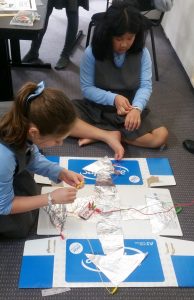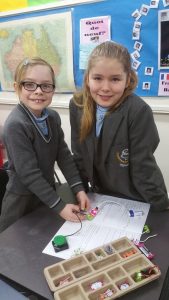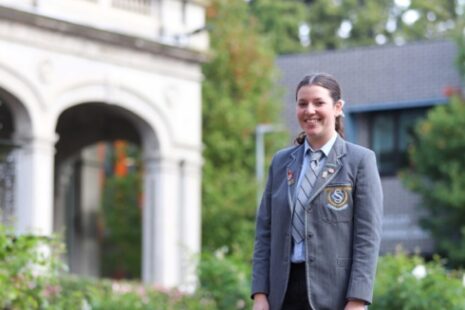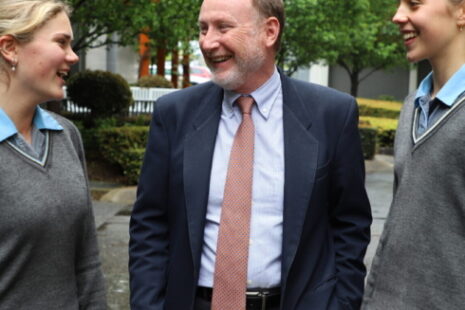What is STEM Education?

STEM education creates critical thinkers through instilling a sense of intrigue and wonder. It encourages children to challenge their world, understand new concepts, make well-informed decisions and pursue new interests.
How, and why, has it become important and what has Year 3 being doing in STEM?
As a Junior School educator it is a privilege to be given the opportunity to educate, nurture and inspire each student in my care. My role has many responsibilities, but the most important one is creating a learning environment and providing the educational opportunities to equip my students with the skills, capabilities and values to be confident, socially aware and empowered global citizens. One of the challenges I need to embrace in order to fulfil this responsibility is being able to respond to the changing needs and demands of the 21st Century. These demands require me to develop a new approach to education and to prepare my students for future study, careers, and citizenship.
One of the most significant challenges facing society, education and the young people of today is the changing nature of work. With many industries and traditional career paths disappearing largely due to automation, globalisation and the constant change created by technological innovation and the internet, there has been an unprecedented and corresponding push in education to revitalise interest in subjects related to Science, Technology, Engineering and Mathematics (STEM).
What has caused the push to revitalise STEM learning?
With an increasing demand for STEM trained graduates by our largest global companies since the start of the 21st Century and, the low enrolment rates in these fields of study in many countries across the world, it not surprising that we have a shortage of skilled workers in STEM related jobs and careers. The rapidly changing nature of the employment market and, new science and technology skill sets and capabilities required by graduates to have, has presented new challenges for both schools and tertiary education globally.
“International research shows that building STEM capacity across the population is critical in helping to support innovation and productivity regardless of occupation or industry. Consistent with this research, industry surveys show that STEM literacy is increasingly becoming part of the core capabilities that Australian employers need. PricewaterhouseCoopers has estimated that changing 1 per cent of Australia’s workforce into STEM-related roles would add $57.4 billion to GDP.” (1)
The growing effects of skill shortages on global economies and, the pressure on individual countries to adapt and secure their nations economic futures, has led many governments to take proactive steps to solve the problem. Whilst many industries adjust and provide opportunities for employees to re-skill or shift industries, schools and tertiary institutions have been targeted by governments globally as holding the solution to this decline in STEM trained workers. Developing knowledge and skills in coding, design process, algorithmic and computational thinking are some of the skill sets required by employees to prepare them for the jobs of the future. These skill sets, capabilities and the STEM related courses to teach them, are now filtering into tertiary institutions and are embedded into the national and state government curriculum statements. There is now mounting research and evidence supporting the shift to more STEM based learning opportunities in education.
It is important to note that the push to provide more STEM based learning in our schools and tertiary courses is not aimed at specifically producing more programmers and mathematicians. It is however, encouraging students to study STEM subjects and show them some of the great careers built on Science, Engineering, Mathematics and Technology. It is also hoped that by starting this interest at the school level it will help increase the number of students taking up STEM subjects in higher education and in their careers and help keep Australia competitive internationally in these important fields.
In recent years, politicians and economists have promoted the idea that a strong economy in the 21st Century will prosper through Science, Technology, Engineering and Mathematics (STEM). We know that children entering the education system in 2016 will be joining a very different workforce in 2030. In fact, 75% of the fastest growing occupations now require STEM skills and knowledge and yet, Australian enrolments in almost every STEM subject area at university level have continued to fall over the last decade. Australia has a declining rate of STEM-related course completions which have decreased over the past 10 years from 22 per cent to 16 per cent. In contrast, in Singapore, 34.75 per cent of students graduated with a STEM qualification in 2014. In China 46.9 per cent approximately 1.5 million people completed STEM programs. Strong performance in STEM is critical to future economic growth, encouraging curiosity and reflection in the students of today will ensure we come closer to closing the STEM skills gap in Australia.
What is STEM education?
STEM education is an interdisciplinary approach to learning which blends the study of Science, Technology, Engineering and Mathematics (and ART – STEAM) into a cohesive learning paradigm. Rather than teaching the disciplines as completely separate and discrete subject silos, as they are often referred to, STEM challenges learners to draw connections between their learning and the real-world.
STEM focuses on these areas together – not only because the skills and knowledge in each discipline are essential for student success, but also because these fields are deeply intertwined in the real world and in how students learn most effectively. The underlying purpose of STEM education is therefore to equip students with critical thinking, problem solving, creativity and communication skills, necessary for future success in a wide range of occupations.
STEM education creates critical thinkers through instilling a sense of intrigue and wonder. It encourages children to challenge their world, understand new concepts, make well-informed decisions and pursue new interests.
STEM lessons:
- focus on real-world issues and problems
- are guided by the design process
- immerse students in hands-on inquiry and open-ended exploration
- involve students in collaborative co-construction of knowledge
- require children to apply knowledge and skills to solve problems and naturally inspire them to seek further knowledge and improve their skills
- allow for multiple right answers and re-frame failure as a necessary part of learning.
Why is STEM important at St Catherine’s?
 We are frequently reminded how vital it is that we engage girls in STEM based learning opportunities. There is a significant disparity between the numbers of young women enrolled in STEM qualifications – only 19 per cent. While women make up 60 per cent of the non-STEM based course qualifications.
We are frequently reminded how vital it is that we engage girls in STEM based learning opportunities. There is a significant disparity between the numbers of young women enrolled in STEM qualifications – only 19 per cent. While women make up 60 per cent of the non-STEM based course qualifications.
The reasons underpinning this issue range from a lack of female role models, to gender stereotyping and less family-friendly flexibility in STEM fields. However, regardless of the reason, we cannot afford to lose half of our potential innovative minds and, we should be encouraging women into STEM fields in order to continue to be a global leader in innovation.
Over the years, Australian women have been at the forefront of many important discoveries and innovations in the STEM fields, such as the revolutionary spray-on skin for treating burns victims, developed by Dr Fiona Wood. However, the number of innovations by Australian women is still dramatically lower than that of their male counterparts. This poses the question, if more women were encouraged to be actively involved in STEM fields, how much higher could our national potential be? The solution? Encouraging women in STEM must begin at an early age. In order to change the current gender stereotypes, women must find inspiration from other women and realise their potential to contribute towards global innovation.
What has the Junior School being doing in STEM based learning?
In 2016, a specialist STEM teacher provided groups of students from across our School a comprehensive curriculum of STEM based learning experiences. In the Junior School, Year 3 were targeted as a commencement point to introduce the STEM concept and skills, with weekly one hour sessions provided during the year.
So far, the Year 3 STEM program has exceeded expectations with every girl gaining new skills and knowledge in areas such as coding, electrical circuits and design process thinking. One of the unique aspects of the STEM program has been the ‘hands-on’ nature of learning. In Semester one, the girls used small construction kits (Little Bits and Makey Makey) to explore the concepts of electrical circuits, creating moving objects and mini machines using sensors, switches and battery power. They also learnt skills in computation thinking, debugging code and applying these skills to create coded algorithms to solve problems in digital games.
 By working collaboratively in pairs, each week the girls were challenged to conceptualise problems, explore solutions, plan, construct and then test their ideas. Often when something didn’t work as planned, they had to check and revise their design and tinker with the parts before they solved the problem. The very ‘hands-on’ and collaborative nature of the age appropriate learning experiences has sparked the girl’s sense of play and enthusiasm for ‘learning by doing’. It has been wonderful to observe the girls’ increasing levels of patience and perseverance driven by their curiosity and determination to solve meaningful and engaging problems. The girls have always looked forward to their weekly sessions with excitement as they anticipate what new things they will build and create.
By working collaboratively in pairs, each week the girls were challenged to conceptualise problems, explore solutions, plan, construct and then test their ideas. Often when something didn’t work as planned, they had to check and revise their design and tinker with the parts before they solved the problem. The very ‘hands-on’ and collaborative nature of the age appropriate learning experiences has sparked the girl’s sense of play and enthusiasm for ‘learning by doing’. It has been wonderful to observe the girls’ increasing levels of patience and perseverance driven by their curiosity and determination to solve meaningful and engaging problems. The girls have always looked forward to their weekly sessions with excitement as they anticipate what new things they will build and create.
St Catherine’s Junior School STEM program will continue to expand and evolve as students build and transfer their new skills across Year levels and make connections with other areas of their curriculum.
Here are some comments from students about the Year 3 STEM program.
“I like being able to make cool things and work with your friends. I really like what we can make.” Elisa Wang
“You get to use your imagination.” Portia Gowrie
“I like that you can create your own stuff.” Natalie Wang





